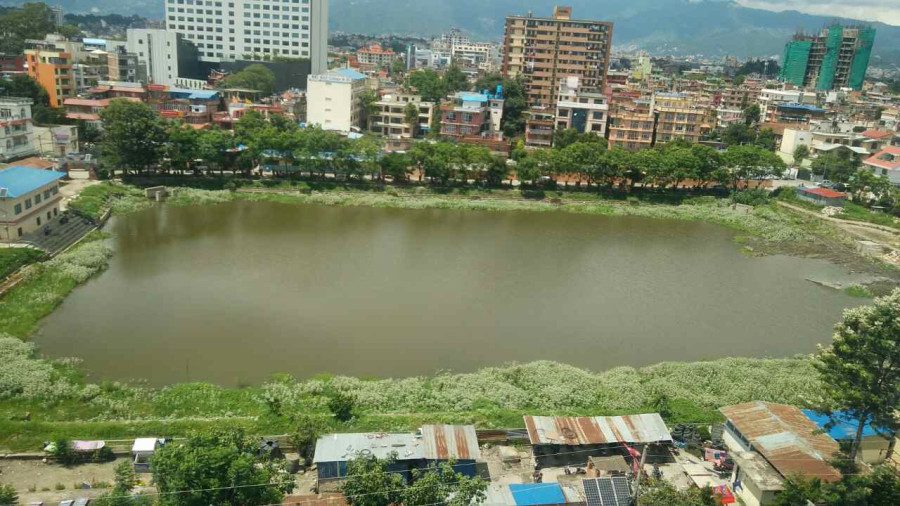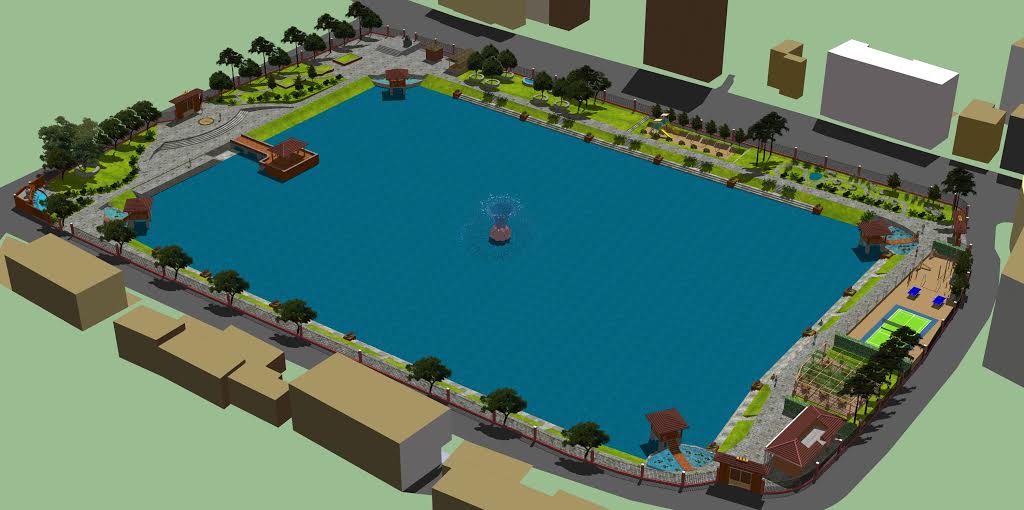Valley
Conservationists are not so keen about Kamal Pokhari restoration project
Kathmandu Metropolitan City is restoring the centuries-old pond as a recreation centre complete with small artificial ponds at four corners and a fountain at the centre.
Srizu Bajracharya
As Rajendra Singh takes a walk around Kamal Pokhari, where restoration of the pond is underway, he looks content. Singh believes in a few years time Kamal Pokhari’s face will be changed—it will be a place for people to enjoy leisure time in the heart of Kathmandu.
“The pond is going to be developed as a recreation park. We will have a space for a children's playground and an area for people to play sports in the southwest area of the park. Kamal Pokhari will be cleaner, beautiful and full of life,” said Singh, chair of Kamal Pokhari Chhath Puja Samaj, who is also currently overseeing the restoration.
Like Singh, many local residents of the area are happy with the ongoing restoration work. For years the pond had looked unkempt. The project also hopes to have the pond filled with clean water throughout the year.
However, hydrology experts say the plan noticeably fails in understanding the purpose of a pond and that the general public is unaware of the loss the ambitious beautification project will cost: ecological imbalance.
“The main purpose of a pond is to recharge groundwater; it is to maintain the temperature of the surrounding and to mitigate urban floods in the area,” says Prakash Amatya, a water conservationist. “But this whole project disregards these purposes and focuses only on the beautification to develop it as a recreational space.”
Kamal Pokhari, an unkempt natural pond at the centre of Hattisar, named for the lotus flower that bloomed in its waters, in recent years, has become the prime host for Chhath celebrations in the Capital with even the President of the country joining the ceremony here.
Over the years, many projects have tried to manage and beautify the pond. But none were successful. But neither was any as ambitious as the current plan by Kathmandu Metropolitan City.
According to authorities of the restoration project, the ongoing first phase of the project focuses primarily on the beautification of Kamal Pokhari.
“We are working to beautify Kamal Pokhari and we have not used any concrete,” said Prem B Shrestha, engineer and project coordinator of the Kamal Pokhari restoration project.
Amatya, however, refutes this claim saying concrete has been used below the water.
The City’s design on the site boasts a lotus shaped fountain in the middle and smaller ponds in the four corners of the pond that will grow lotuses. Besides these inputs, the design also draws plans to build an outlet in the southwest of the pond.

“Our design assures that the water remains clean with the fountain at the centre for water aeration. We also have tried to ensure that the water level does not deplete in the pond completely, and for that we will be using mechanisms that can hold water in some points of the pond,” said Priyanka Pradhan, the designer with the City Planning Commission.
Kathmandu Metropolitan City hopes to complete the restoration by May 2021 next year.
However, environmentalists and heritage activists remain unconvinced with the approach of the restoration.
They fear that Kamal Pokhari is going the Rani Pokhari way.
“The Rani Pokhari we now see only serves the purpose of beauty, it does not serve the large purpose it once used to, of mitigating floods and maintaining the water cycle of the area,” said Amatya. “If we don’t raise our voices now, Kamal Pokhari is going to be next. A pond’s function goes beyond its social aspect, it serves for the balance of nature.”
For long, environmentalists have been challenging the government’s way of restoring ponds in the country. When a boring system was placed in Rani Pokhari to replenish the pond, heritage activists and water experts demanded the authorities remove the deep wells from the pond for months.
And now Kamal Pokhari’s restoration is set to make the same mistakes.
“We are bringing water from Melamchi, but we are also going to dig a boring well of about four inches,” said Singh.
When the Post pointed out to him how the boring system would go against the idea of the natural recharging of the pond’s water, Singh pointed out that tall buildings in the surrounding areas were already boring for groundwater.
Since the 1990s households and businesses across the Kathmandu Valley have been accessing groundwater for water through boring systems.
“The water here will be cleaner after the restoration as we have also ensured an outlet system which Rani Pokhari does not have,” said Singh.
Many locals also believe that since Kamal Pokhari does not have a historical and archaeological value like Rani Pokhari, making it a recreational park is not an issue.
“Kamal Pokhari is not a historical pond like Rani Pokhari. It is just an open area where water from around the area gets collected,” said Singh.

But the authorities of the project have not conducted any detailed study of the area to address its historicity; rather they have been approaching the pond only as a mere development project to appease the locals of the area, say experts and researchers.
According to Sudarshan Raj Tiwari, a conservation architect and former dean of the Institute of Engineering, Kamal Pokhari could be older than Rani Pokhari going back to the Licchavi era.
“Kamal Pokhari could have been a sukhaparikha, a pleasure pond, for the whole of the capital town of Maneswor or Bishalnagar during the Lichhavi period,” he said. “Historically, rulers used to build big ponds around their royal residence and Kamal Pokhari is next to Naxal.”
Naxal is adjacent to Bishalnagar, the capital of Licchavi kings.
The wetland of Kamal Pokhari once brimmed with water from rain and drainage pipelines from around the area.
“The area is closer to Natu and Kwatu tole (Dhobidhara area) where there were wells and dhunge dharas [stone spouts] in the late Malla period and these could have been the water sources to the pond,” said Tiwari.
Buddhi Narayan Shrestha, another researcher, also believes that the Malla kings made use of the pond.
“When I had researched about Kamal Pokhari about 40 years back, one of the elders at the time had said that the lotus flower of this pond was used by the Malla kings for their pujas, which show that Kamal Pokhari’s history goes further back than what is assumed by the locals now,” says Shrestha, who has studied Kamal Pokhari.
Both Tiwari and Shrestha believe that the pond should look to retain its naturalness and ecological functions.
“Since it is Kamal Pokhari, nothing should take the centre stage than the lotus itself and ideas of eateries, and recreation should not be part of the pond because it will all be commercial and that will change the milieu of the place,” said Shrestha.
Besides the forsaken purpose of the pond, Kamal Pokhari over the years has also suffered with encroachment of its areas. Years back Kamal Pokhari was spread over 40 ropanis, said the people the Post talked with. But with years, the size of the pond has shrunk.
“I remember in 1977 when we had mapped the area of the pond, it was over 30 ropanis,” said Shrestha, who at the time used to be the chief survey officer at the Technical Planning Survey Department. “And at the time itself the area was already encroached upon from the south and now they have also built a road and therefore the area of the pond has contracted visibly over the years.”
As Kathmandu continues to urbanise rapidly, open spaces like Kamal Pokhari will be integral to keep nature in balance, conservationists say.
“It’s frustrating how people and the authorities can’t see how they are ruining their own environment by opting for beauty over nature,” said Amatya.
Others like Tiwari are more circumspect.
“It’s not that the pond cannot be rebuilt as a recreation centre but we need to see that the pond serves its ecological function,” said Tiwari. “For example, we can ensure that with the traditional methods of bricklining and using black cotton soil.”




 12.88°C Kathmandu
12.88°C Kathmandu











